Family : Calopterygidae

Text © Prof. Santi Longo

English translation by Mario Beltramini
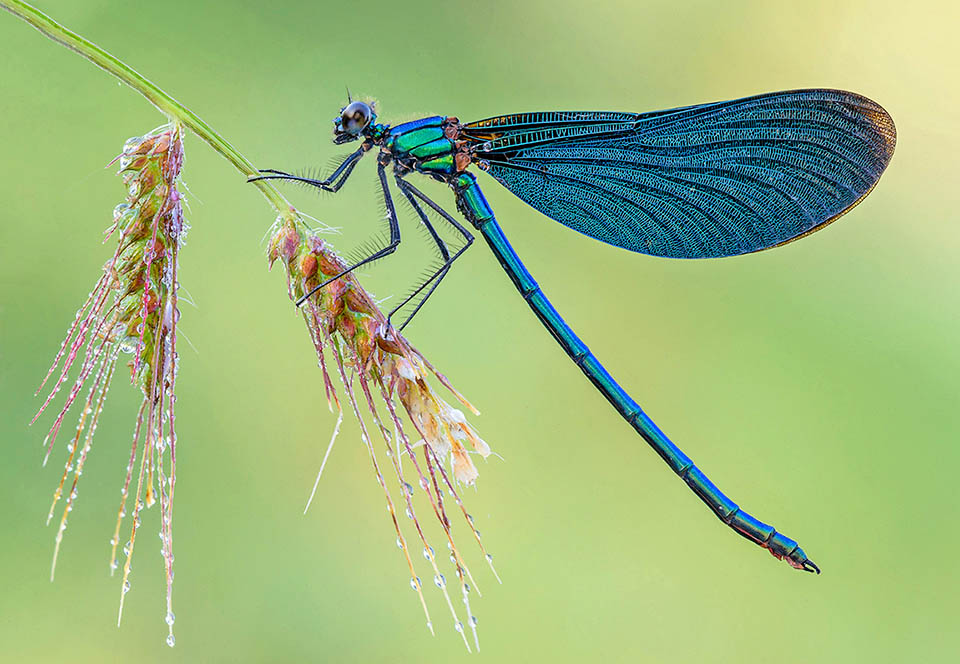
With 50-70 mm of wingspan, Calopteryx virgo has a Euro-Asian distribution up to more than 1000 m of altitude © Raffaella Coreggioli
The Beautiful demoiselle, Calopteryx virgo (Linnaeus, 1758) is one of the more than 4.000 species of the order of the Odonates, considered within the winged insects, pterygote, most primitive, commonly known as dragonflies.
Ancestors of the Odonata are considered the fossil Protodonata, among which stands the species of the
Carboniferous, Meganeura monyi (Brongniart, 1893) whose wingspan exceeded the 70 cm. Due to the morphological characteristics the genus Calopteryx is included in the suborder Zygoptera.
The adults are commonly indicated as Damsels, because of their elegant and delicate look. They have well spaced compound eyes and similar fore and hind wings, that in the resting state are kept vertical and approached.
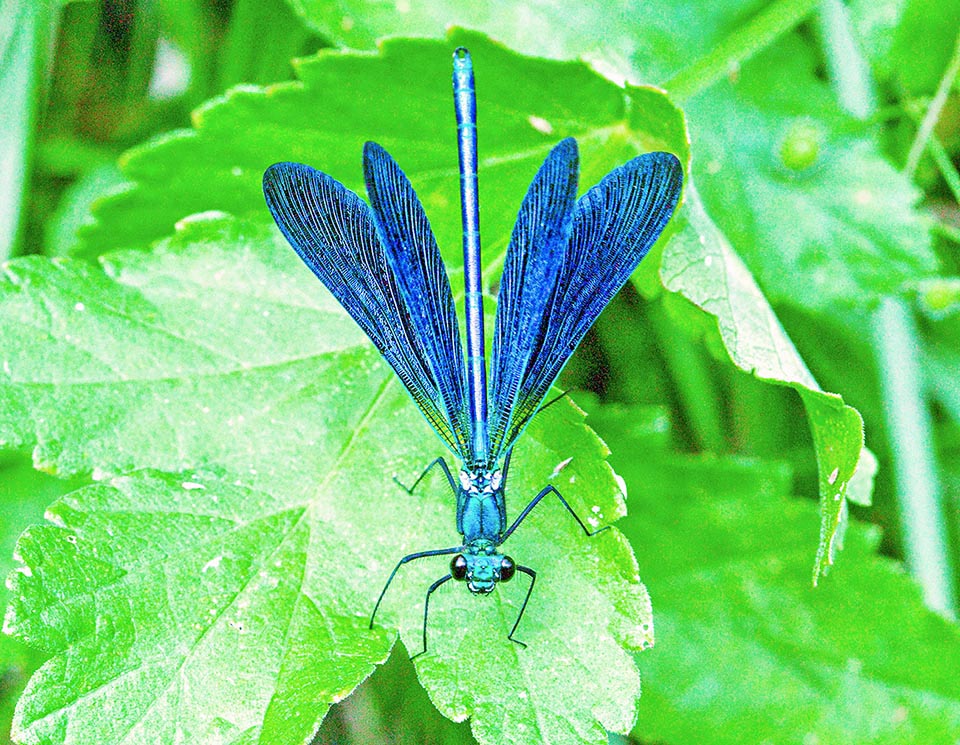
The wings, equal in shape and in development, are approached when resting. They are metallic blue in the males and iridescent dark brown in the females © G. Mazza
The generic term Calopteryx is a clear reference, in Greek, to the beautiful (kalòs) wings (pteryx) and the specific epithet “virgo”, virgin in Latin, evokes the virginal delicacy of the body.
Zoogeography
The Beautiful demoiselle has a Euro-Asian distribution; its range in the European continent reaches the Scandinavian peninsula (Sweden and Norway), Finland, including the large peninsulas of the Mediterranean. South, it is present up to a small area of Mediterranean Morocco. In all Italian low mountain areas up to 1000 m of altitude is reported the subspecies Calopteryx virgo meridionalis Sélys, 1873, whilst North, is present Calopteryx virgo padana Conci, 1956.
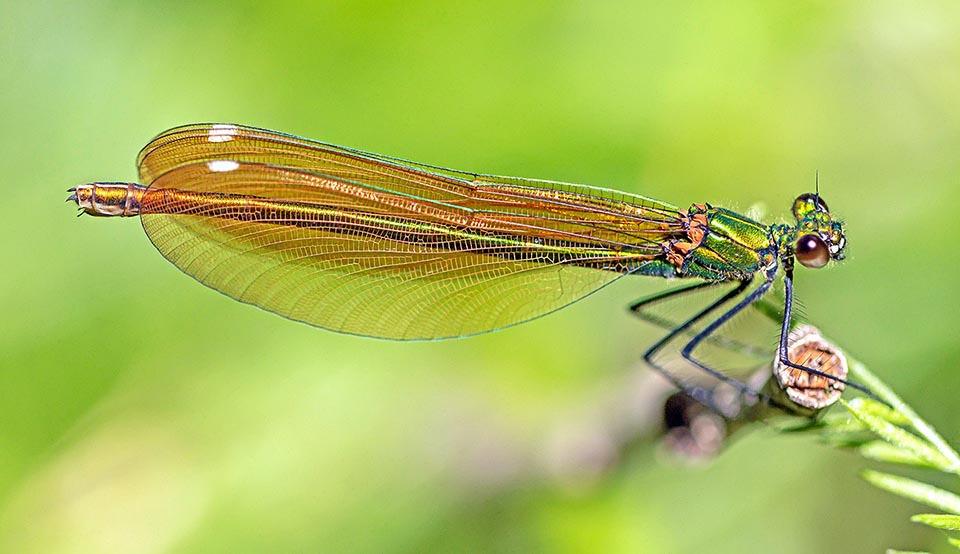
Moreover these display on the fore margin, near the apex, a characteristic pale, opaque cell called pterostigma © Pipa Terrer
In Asia, Calopteryx virgo is diffused in the temperate and cool areas of the whole continent with exception of the desert and high mountain areas. In Japan is present the subspecies Calopteryx virgo japonica Sélys, which some consider as a separate species.
Ecology-Habitat
The adults are present from late April to September close to bodies of water, where do grow trees, shrubs or herbaceous plants with a sufficiently high stem, where they can rest and monitor the surrounding environment.
The juvenile stages live exclusively in flowing waters, cool or cold, rich in oxygen, where they prey on aquatic insects.
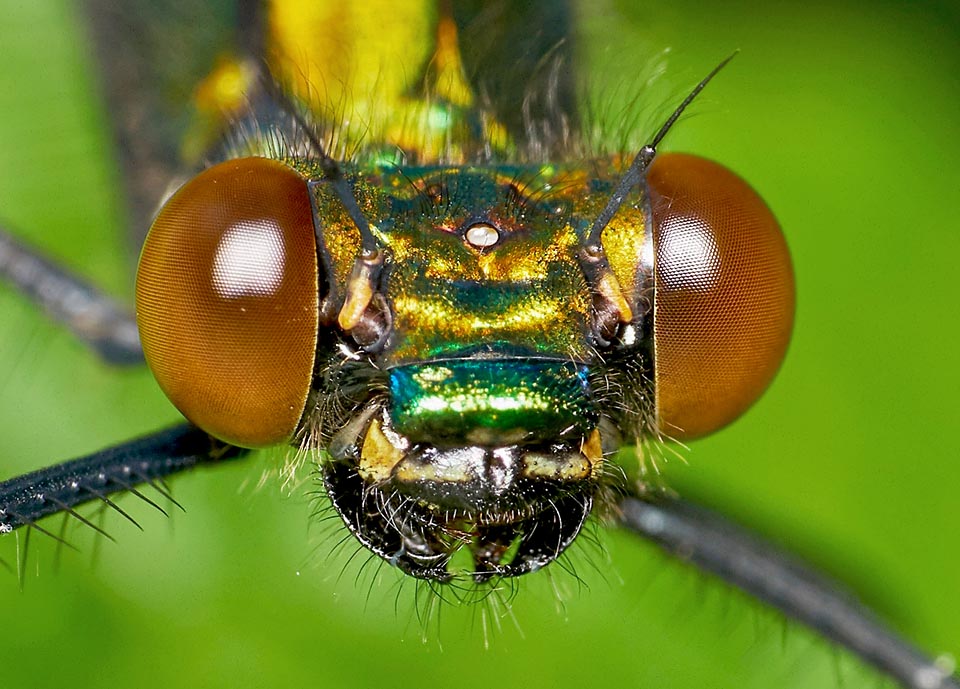
The compound eyes, well-spaced, allow to evaluate well the distances for seizing flying insects. In the foreground, on the head, one of the 3 ocelli present in the dragonflies © David Williams
Morphophysiology
The adults have a tapered body, about 50 mm long. The head is dichoptic, that is with compound eyes well spaced by a large cervical zone that has even three simple eyes called ocelli. The wings have different metallic colours in the two sexes. The fore ones are the same, in shape and development, as the hind ones. In the rest position they are approached to each other and kept vertical. The wingspan varies from 50 to 70 mm.
The males have a metallic blue-green body and the wings, initially brown, become later of a nice metallic blue colour. The last segments of the abdomen are ventrally of a pink colour.
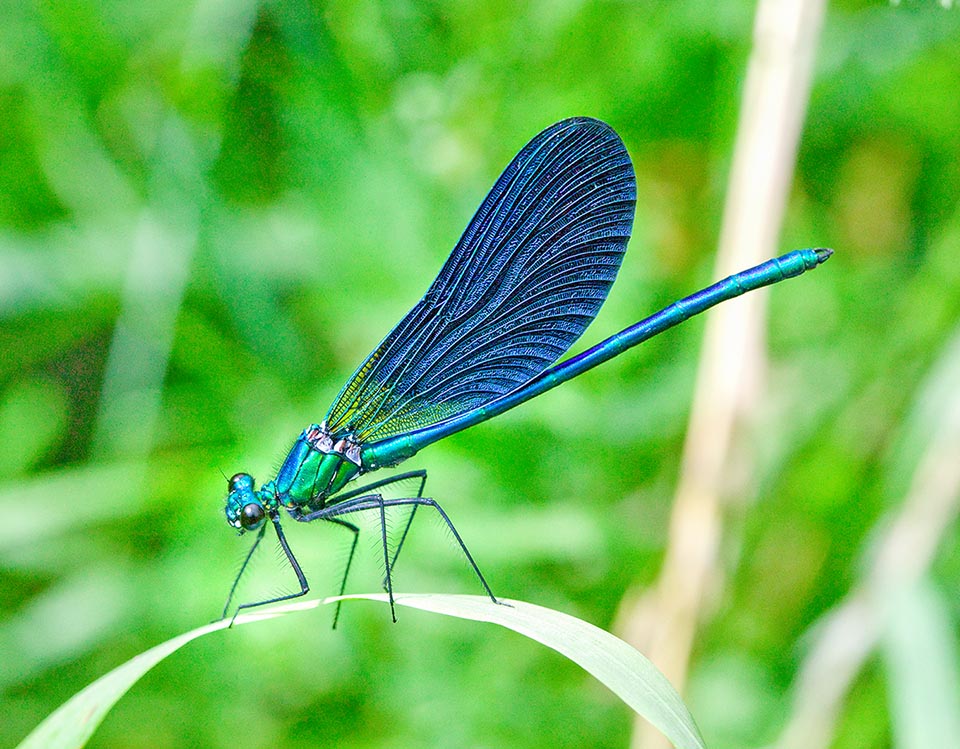
Males are territorial and control a small area waiting for a prey or for a female © Giuseppe Mazza
The copulatory organ, due to a peculiar functional translation, is located in the second and third segment of the abdomen, where it has formed a secondary organ for the mating not connected with the genital apparatus.
The body of the females is brown metallic greenish; the wings are dark brown with iridescent reflections, on the upper margin, close to the apex, present a clear cell, opaque, called pterostigma. The terminal part of the abdomen is brown, equipped with valves that form the ovipositor.
The adults help themselves with the fore legs equipped with pretarsal nails for seizing and holding still the flying prey and while eating them placed on the vegetation.
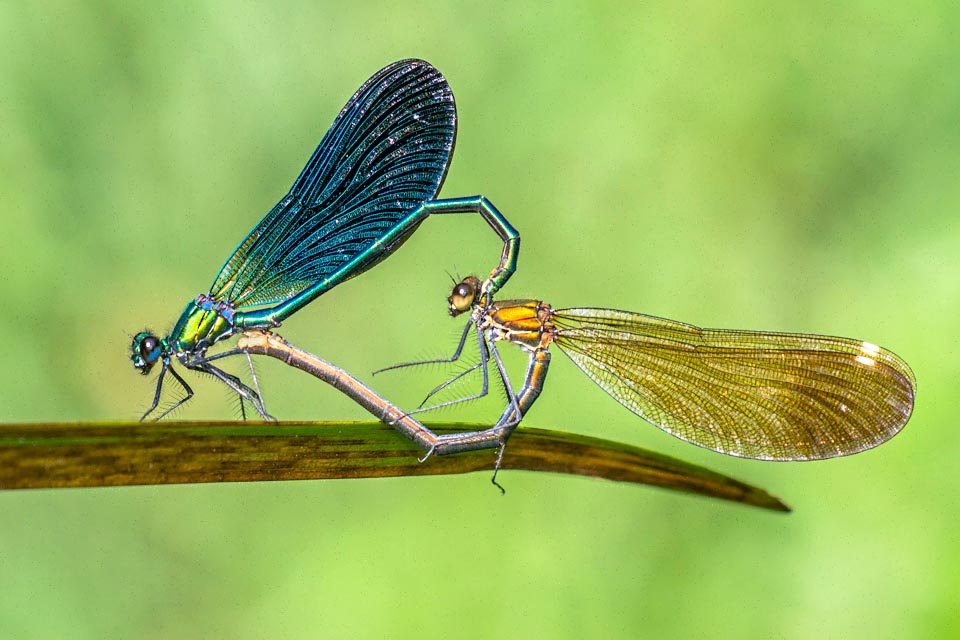
For mating the male transfers the sperm in a particular copulatory organ, called of substitution, present on the thorax. Then with cerci, it seizes the female on the neck and obliges her to bend the abdomen until when the genitals touch. The process may last even long with bodies that draw the romantic form of a heart © Santiago Monteagudo
The juvenile stages, neanids and nymphs, are aquatic, and perform 10 to 12 moults before reaching the adult stage. Their body is slender and equipped with long legs having robust nails, with which they cling to the vegetation. When the development is completed the nymphs are 35 to 50 mm long.
Peculiar feature is the masticatory mouthparts whose lower lip is modified: the first two segments, called premento and postmento, are very long, articulated together so that they can be folded.
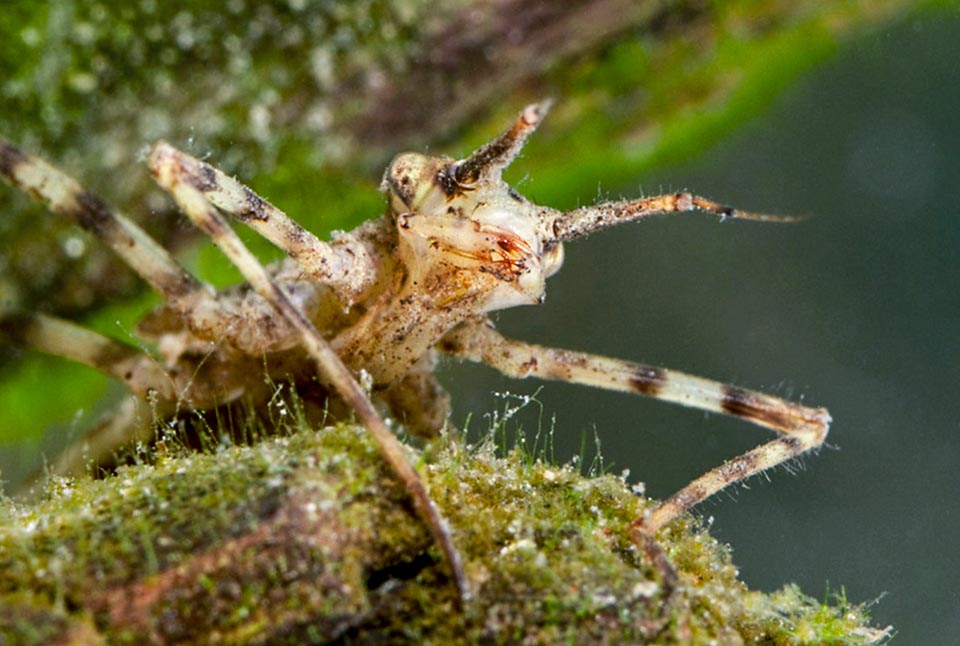
Calopteryx virgo nymph on a rock in a clear stream, feeding mainly on insect larvae © Jan Hamrsky
Each one of the two labial palps is equipped with a mobile spine and together the two parts form a plier used for seizing the prey.
In the caudal part of the abdomen are present the tracheobranches thanks to which they carry out the integumental respiration in immersion, whilst in the thorax are present the stigmata, through which they breathe in open air when they emerge to seize the prey.
Ethology-Reproductive Biology
The first adults appear in spring, and the flutters continue throughout the summer. The males are territorial and control the small area where they catch the flying insects. After about 15 days from the fluttering, they reach sexual maturity and mate with the females entering their territory.
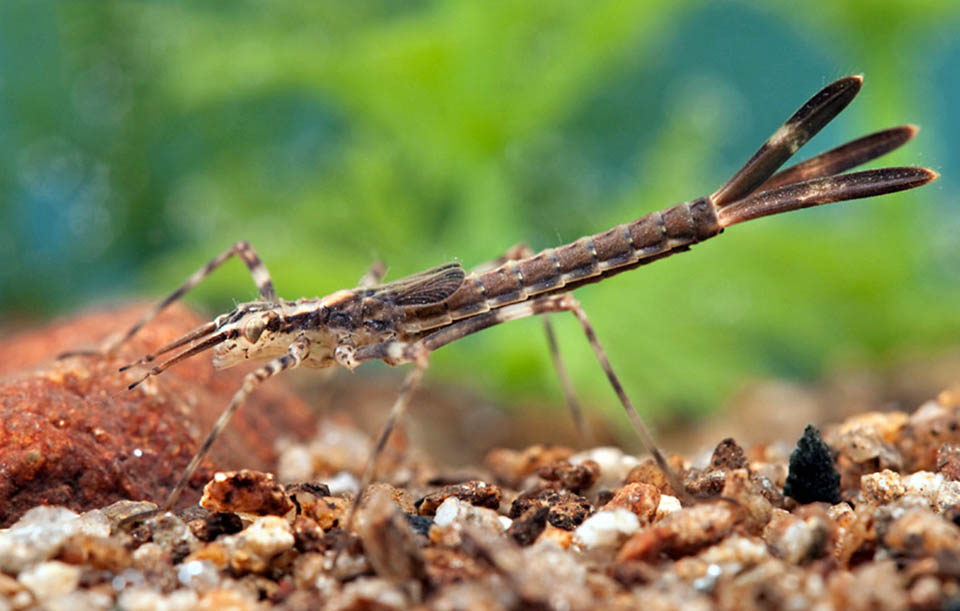
Note the long clawed legs, short wings and the typical shape and colouring of the three anal tracheobranchia for underwater breathing © Jan Hamrsky
Before the copula, they transfer the seminal fluid coming from the ejaculatory canal, into the copulatory organ located in the thorax and, after having seized the female between head and thorax, oblige her to bend her abdomen until the genitals come into contact.
The newly fluttered females tend to get far from the water, looking for prey and for a reproductive partner. Between late May and June they oviposit in the stems of aquatic plants, immersing the abdomen in the water and piercing the vegetable tissues with the ovipositor. In order to complete the deposition, they may remain submerged for up to 90 minutes. The juvenile stages complete their development in about two years.
Synonyms
Agrion colchicus von Eichwald, 1837.
